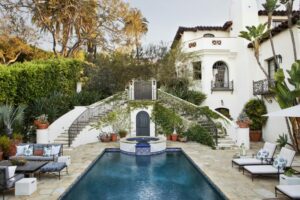
Los Angeles luxury homes are renowned not just for their affluent owners but for their breathtaking architectural styles that blend history, innovation, and Hollywood glamour. From Mediterranean elegance to sleek modernism, the city offers a living gallery of design. Here’s a closer look at several iconic styles that define luxury in L.A.
- Spanish Colonial Revival / Mediterranean Villa
Characterized by red clay tile roofs, white stucco walls, and stately arches, this style is deeply rooted in Southern California’s early 20th-century heritage. Lavish courtyards, wrought-iron grilles, and terracotta flooring channel an Old World elegance. The image of the sprawling Mediterranean estate (first slide) captures this aesthetic perfectly: organic landscape integration, courtyards with pools, lush greenery, and an air of timeless luxury. This style remains the darling of upscale neighborhoods like Hancock Park and Beverly Hills.
- Hollywood Regency & Old Hollywood Classicism
Developed in the ’50s and ’60s by visionaries like Robert Woolf, Hollywood Regency blended European classicism with Hollywood’s glamorous flair. Think bold symmetry, lacquered surfaces, dramatic lighting, sweeping staircases, and mirrored accents. These homes were designed to dazzle—perfect for celebrity entertainments and cinematic aesthetics .
If you look closely at the Regency-inspired contemporary mansions (second carousel image), you’ll note grand entrances, rhythmic windows, iron detailing, and geometrical façades—modern nods to classical roots.
- Mid‑Century Modern & International Style
A hallmark of postwar luxury in L.A., this style emphasizes horizontal lines, open floor plans, floor-to-ceiling glass, and seamless indoor-outdoor integration. Residences by architects like Richard Neutra, Charles and Ray Eames, and Ray Kappe are prime examples.
- Neutra’s Lovell House (completed in 1929) was groundbreaking: the first steel-frame residence in the U.S., using gunite and minimal massing to achieve a Modernist vision.
- The Eames House (Case Study House No. 8, 1949) became an icon of functional artistry and is still preserved as a museum today.
- Kappe Residence (1967) innovated with concrete platforms nestled into hillside terrain, merging structure and nature.
Recently, a Lloyd Wright–designed mid‑century modern in the Palisades—known as the Newman Residence—hit the market at $12.8M. It’s notable for its open layouts, angular forms, and use of natural materials—classic signatures of this enduring style.
- Mayan Revival / Textile‑Block Ornamentation
Unique to L.A. are Frank Lloyd Wright’s textile‑block homes, inspired by pre-Hispanic architecture and built in the 1920s. The Ennis House (1924) and Storer House (1923) feature intricate concrete blocks with geometric, Mayan-influenced designs.
- The Ennis House is famed for its cinematic presence—appearing in films like Blade Runner—and remains an architectural monument.
- The Storer House, perched in Hollywood Hills, uses the textile-block motif to appear as an organic extension of the hillside.
- Contemporary Minimalism / Modern Interpretation of Regency
The newest wave of luxury in L.A. favors crisp, minimalist aesthetics grounded in timeless proportions and classic massing—often dubbed Contemporary Regency. These mansions are characterized by monochrome palettes (often whites or grays), steel-framed windows, limestone detailing, and elegant iron accents.
Recent designs by firms such as Robert A.M. Stern Architects channel Old Hollywood glamour through large gallery spaces, curved stair cases, and indoor-outdoor pavilions—dominated by refined symmetry and carefully curated material palettes.
Choosing Your Architectural Identity
For admirers of historic charm, Spanish Colonial Revival offers warmth and Mediterranean flair. Mid-century modern appeals to those seeking sleek lines and openness, bridging indoors and outdoors. Textile-block Mayan Revival homes are for visionaries enamored with cinematic heritage. And the latest Contemporary Regency blends classic elegance with minimalist restraint.
What ties them all together is context—these styles didn’t just arrive in L.A.; they were born of its geography, climate, and celebrity culture. The construction of Neutra’s Lovell House or Wright’s Ennis House happened because L.A.’s light, hills, and affluent clientele demanded architectural innovation. Nearly a century later, that spirit endures.
A Future of Fusion and Reinterpretation
Despite recent losses (e.g., wildfire impacts on heritage sites), L.A.’s luxury architecture is still vibrant and evolving. Contemporary mansions now draw from several traditions—Marrying Regency symmetry with modern materials and open layouts, or combining mid-century clarity with indoor-outdoor living.
Whether you’re an architecture buff, a developer, or a homeowner, L.A.’s luxury homes offer a rich tapestry of styles to explore. These residences don’t simply house; they make statements—about culture, wealth, and the art of living in one of the world’s most iconic cities.
Which style resonates with you? Dreaming of mid‑century tranquility, Mediterranean romance, or minimalist grandeur? L.A.’s luxury home panorama invites a personal connection to design history and craftsmanship.
